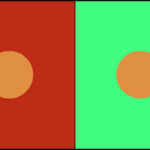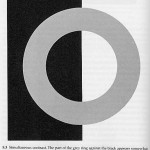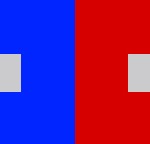Materials
- all gouache paints from Supply List or Reeves Color Set
- brushes, water containers, palette
- ruler, t-square, exacto knife
- pencils
- 9×12″ bristol
- glue
Critique:
Today you will be using the rubric to assess your neighbor’s project. Put all Assignment #4 work on your desk (check to make sure you have all parts of the project). Using the rubric provided compare the Assignment #4 guidelines against the work your neighbor has presented.
- Free-Study #1 (Combined Saturation with the Illusion of Space)
- Free-Study #2 (Based on Ben Snead’s work)
- Creative Process Book
Discussion/Lecture
Color Interaction
- Simultaneous Contrast: When two colors come into contact, the contrast intensifies the difference between them.
- Example #1: When a middle gray is surrounded by dark gray it appears lighter than when surrounded by a lighter gray.
- Example #2: Yellow-green surrounded by green appears more yellow, but if surrounded by yellow appears more green.
- Example #3: Complementary hues have the most striking effect– blue is most intense when seen next to orange.
- Example #4: Gray or white next to a pure hue, like red, will cause the gray to take on its complement, green.
- Complementary Colors and After Images: Afterimage is an optical effect that is induced from color combinations. If a color and a neutral gray placed side by side the gray will appear tinted with the complement. Due to the influence of afterimage, our brains try to balance the color with its complement.
- Example: When we see a blue-violet circle on a green square, there is a small ring of red-violet at the intersection of the background and the circle. The reddish afterimage of the green is blended with the blue of the circle to create a red-violet illusion. If the same color is placed on a gray background, the circle appears bluer.
- Optical Mixing: When a field of color is composed of small, disparate points of color, the mind fuses the colors into a comprehensible whole.
- Example #1: Four-color printing process uses overlapping dot screens of Cyan, Magenta, Yellow and Black to produce a wide range of hues.
- Example #2 : Digital imaging on the computer screen uses tiny pixels of color to produce gradations of hue.
- Example #3: A mosaic or drawing uses tiny pieces of stone or drawn marks to create a field of color.
Josef Albers: The Interaction of Color
- Josef Albers was a student of the Bauhaus in Germany and color educator at the Black Mountain College and Yale. His experiments in color relationships are used throughout the world in the study of design and color.
- Classic experiments involved making one color appear as two by placing it next to different background colors.
References:
- Use this tool to experiment with color interactions: http://www.jellocube.com/screendesign/simulcon.swf
- Here’s another: http://rotorbrain.com/foote/interactive/hacks/colorinteraction1.html
Lab
Assignment #5 : Color Interaction Pairings
- Goal: Create a total of 8 paired interaction color studies, making 1 color appear as 2 different colors by changing its surrounding color. Each PAIR consists of 2 interactions for a total of 4 squares. The small square should be the same for each pair.
- 2 pairs – achromatic gray studies will explore interactions by shifting value.
- 2 pairs – color studies will explore interactions by shifting value (with color)
- 2 pairs – color studies will explore interactions by shifting hue, but not value.
- 2 pairs – color studies will explore interactions by shifting hue and value.
- Extra Credit: 2 pairs – color studies will attempt to make two different colors look as a like as possible.
- Limits: Using leftover and new color scraps from your previous saturation studies, make large squares 2×2″ and small squares 1/2 x 1/2″. The small squares will sit in the middle of the large squares and should be the same for each pair.
- Process:
- START with Value: Using achromatic grays (black and white gouache), vary the value of the large square to alter the perceived value of the small square. The small square should be the same value for each pair.
- Refer to the Assignment #5 Guidelines for more info.
HOMEWORK
- Complete 2 pairs of achromatic gray interactions (you may have to make several attempts)
- Come prepared with painted color scraps and paints, brushes, etc.
- REwork Saturation Free Studies #1 & #2, based on a critique.












